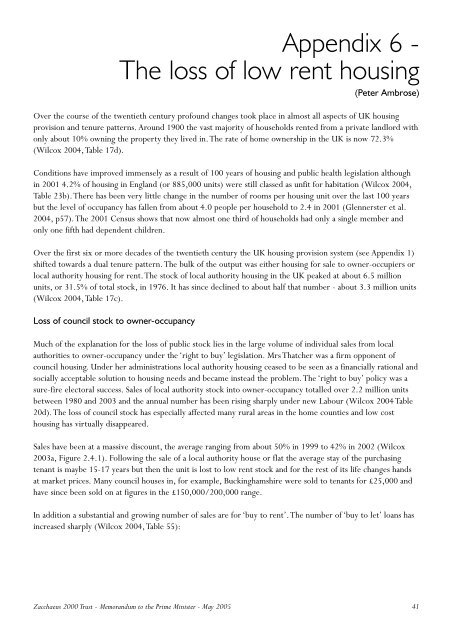Memorandum-to-the-Prime-Minister-on-Unaffordable-Housing
Memorandum-to-the-Prime-Minister-on-Unaffordable-Housing
Memorandum-to-the-Prime-Minister-on-Unaffordable-Housing
You also want an ePaper? Increase the reach of your titles
YUMPU automatically turns print PDFs into web optimized ePapers that Google loves.
Appendix 6 -<br />
The loss of low rent housing<br />
(Peter Ambrose)<br />
Over <str<strong>on</strong>g>the</str<strong>on</strong>g> course of <str<strong>on</strong>g>the</str<strong>on</strong>g> twentieth century profound changes <str<strong>on</strong>g>to</str<strong>on</strong>g>ok place in almost all aspects of UK housing<br />
provisi<strong>on</strong> and tenure patterns. Around 1900 <str<strong>on</strong>g>the</str<strong>on</strong>g> vast majority of households rented from a private landlord with<br />
<strong>on</strong>ly about 10% owning <str<strong>on</strong>g>the</str<strong>on</strong>g> property <str<strong>on</strong>g>the</str<strong>on</strong>g>y lived in.The rate of home ownership in <str<strong>on</strong>g>the</str<strong>on</strong>g> UK is now 72.3%<br />
(Wilcox 2004,Table 17d).<br />
C<strong>on</strong>diti<strong>on</strong>s have improved immensely as a result of 100 years of housing and public health legislati<strong>on</strong> although<br />
in 2001 4.2% of housing in England (or 885,000 units) were still classed as unfit for habitati<strong>on</strong> (Wilcox 2004,<br />
Table 23b).There has been very little change in <str<strong>on</strong>g>the</str<strong>on</strong>g> number of rooms per housing unit over <str<strong>on</strong>g>the</str<strong>on</strong>g> last 100 years<br />
but <str<strong>on</strong>g>the</str<strong>on</strong>g> level of occupancy has fallen from about 4.0 people per household <str<strong>on</strong>g>to</str<strong>on</strong>g> 2.4 in 2001 (Glennerster et al.<br />
2004, p57).The 2001 Census shows that now almost <strong>on</strong>e third of households had <strong>on</strong>ly a single member and<br />
<strong>on</strong>ly <strong>on</strong>e fifth had dependent children.<br />
Over <str<strong>on</strong>g>the</str<strong>on</strong>g> first six or more decades of <str<strong>on</strong>g>the</str<strong>on</strong>g> twentieth century <str<strong>on</strong>g>the</str<strong>on</strong>g> UK housing provisi<strong>on</strong> system (see Appendix 1)<br />
shifted <str<strong>on</strong>g>to</str<strong>on</strong>g>wards a dual tenure pattern.The bulk of <str<strong>on</strong>g>the</str<strong>on</strong>g> output was ei<str<strong>on</strong>g>the</str<strong>on</strong>g>r housing for sale <str<strong>on</strong>g>to</str<strong>on</strong>g> owner-occupiers or<br />
local authority housing for rent.The s<str<strong>on</strong>g>to</str<strong>on</strong>g>ck of local authority housing in <str<strong>on</strong>g>the</str<strong>on</strong>g> UK peaked at about 6.5 milli<strong>on</strong><br />
units, or 31.5% of <str<strong>on</strong>g>to</str<strong>on</strong>g>tal s<str<strong>on</strong>g>to</str<strong>on</strong>g>ck, in 1976. It has since declined <str<strong>on</strong>g>to</str<strong>on</strong>g> about half that number - about 3.3 milli<strong>on</strong> units<br />
(Wilcox 2004,Table 17c).<br />
Loss of council s<str<strong>on</strong>g>to</str<strong>on</strong>g>ck <str<strong>on</strong>g>to</str<strong>on</strong>g> owner-occupancy<br />
Much of <str<strong>on</strong>g>the</str<strong>on</strong>g> explanati<strong>on</strong> for <str<strong>on</strong>g>the</str<strong>on</strong>g> loss of public s<str<strong>on</strong>g>to</str<strong>on</strong>g>ck lies in <str<strong>on</strong>g>the</str<strong>on</strong>g> large volume of individual sales from local<br />
authorities <str<strong>on</strong>g>to</str<strong>on</strong>g> owner-occupancy under <str<strong>on</strong>g>the</str<strong>on</strong>g> ‘right <str<strong>on</strong>g>to</str<strong>on</strong>g> buy’ legislati<strong>on</strong>. Mrs Thatcher was a firm opp<strong>on</strong>ent of<br />
council housing. Under her administrati<strong>on</strong>s local authority housing ceased <str<strong>on</strong>g>to</str<strong>on</strong>g> be seen as a financially rati<strong>on</strong>al and<br />
socially acceptable soluti<strong>on</strong> <str<strong>on</strong>g>to</str<strong>on</strong>g> housing needs and became instead <str<strong>on</strong>g>the</str<strong>on</strong>g> problem.The ‘right <str<strong>on</strong>g>to</str<strong>on</strong>g> buy’ policy was a<br />
sure-fire elec<str<strong>on</strong>g>to</str<strong>on</strong>g>ral success. Sales of local authority s<str<strong>on</strong>g>to</str<strong>on</strong>g>ck in<str<strong>on</strong>g>to</str<strong>on</strong>g> owner-occupancy <str<strong>on</strong>g>to</str<strong>on</strong>g>talled over 2.2 milli<strong>on</strong> units<br />
between 1980 and 2003 and <str<strong>on</strong>g>the</str<strong>on</strong>g> annual number has been rising sharply under new Labour (Wilcox 2004 Table<br />
20d).The loss of council s<str<strong>on</strong>g>to</str<strong>on</strong>g>ck has especially affected many rural areas in <str<strong>on</strong>g>the</str<strong>on</strong>g> home counties and low cost<br />
housing has virtually disappeared.<br />
Sales have been at a massive discount, <str<strong>on</strong>g>the</str<strong>on</strong>g> average ranging from about 50% in 1999 <str<strong>on</strong>g>to</str<strong>on</strong>g> 42% in 2002 (Wilcox<br />
2003a, Figure 2.4.1). Following <str<strong>on</strong>g>the</str<strong>on</strong>g> sale of a local authority house or flat <str<strong>on</strong>g>the</str<strong>on</strong>g> average stay of <str<strong>on</strong>g>the</str<strong>on</strong>g> purchasing<br />
tenant is maybe 15-17 years but <str<strong>on</strong>g>the</str<strong>on</strong>g>n <str<strong>on</strong>g>the</str<strong>on</strong>g> unit is lost <str<strong>on</strong>g>to</str<strong>on</strong>g> low rent s<str<strong>on</strong>g>to</str<strong>on</strong>g>ck and for <str<strong>on</strong>g>the</str<strong>on</strong>g> rest of its life changes hands<br />
at market prices. Many council houses in, for example, Buckinghamshire were sold <str<strong>on</strong>g>to</str<strong>on</strong>g> tenants for £25,000 and<br />
have since been sold <strong>on</strong> at figures in <str<strong>on</strong>g>the</str<strong>on</strong>g> £150,000/200,000 range.<br />
In additi<strong>on</strong> a substantial and growing number of sales are for ‘buy <str<strong>on</strong>g>to</str<strong>on</strong>g> rent’.The number of ‘buy <str<strong>on</strong>g>to</str<strong>on</strong>g> let’ loans has<br />
increased sharply (Wilcox 2004,Table 55):<br />
Zacchaeus 2000 Trust - <str<strong>on</strong>g>Memorandum</str<strong>on</strong>g> <str<strong>on</strong>g>to</str<strong>on</strong>g> <str<strong>on</strong>g>the</str<strong>on</strong>g> <str<strong>on</strong>g>Prime</str<strong>on</strong>g> <str<strong>on</strong>g>Minister</str<strong>on</strong>g> - May 2005 41


